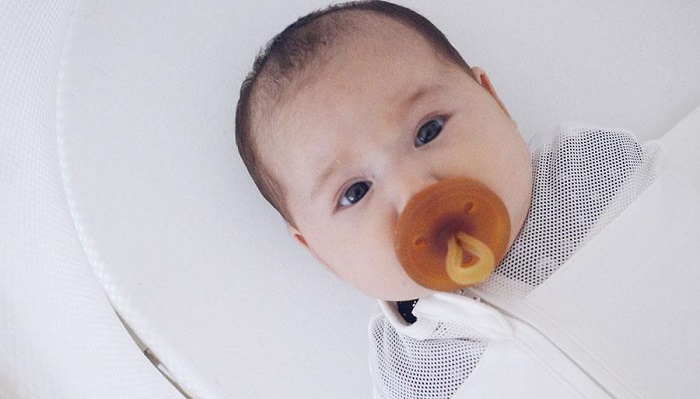Index
When we think of a baby, soon comes the image of a little baby with a pacifier in its mouth, as it ended up becoming characteristic for this phase. But the use of the pacifier is a widely discussed subject among parents and pediatricians, and use has been decreasing more and more due to reports of problems caused by using it.
The use of a pacifier is related to the sucking that the baby has from the mother’s womb and that is indicated as a tranquilizer for them. It ended up appearing as a way to calm the baby by letting “suck” something in a moment of agitation, for example, or even not to be sucking on the mother’s breast. As many babies have this habit of only falling asleep while breastfeeding, mothers use this device to end up making the change and that he can sleep normally, even being easier during the night.
However, due to several occurrences in the babies’ teething birth, considered teeth and crooked dental arch due to the use of pacifiers, the vast majority of pediatricians do not indicate the use to avoid these future disorders. But thinking about these details, companies responsible for the manufacture of children’s products have been developing more and more products that do not prevent and do not affect the correct development of the baby, including the teeth. But does it really work? Doesn’t it affect teething? Nowadays we can easily find a wide variety of orthodontic pacifiersthat were developed on this issue, respecting the entire oral space and reducing the risks of bending the dentition. It is worth noting that in the packaging of each model the appropriate age for that model and nipple is informed, and it is an indication that must be respected due to the size and material of the pacifier.
What Problems Are Generated by the Use of a Pacifier?
The World Health Organization (WHO) indicates that the use of a pacifier occurs from the baby’s 6th month of life. In this way, it does not interfere with breastfeeding, which must be exclusive during this period. After all, the use of a pacifier and its beak other than the mother’s breast, can disturb and confuse the baby, disrupting his feeding and even affecting his weight gain, which is so important in this period. Another factor pointed out by experts is the link between pacifier use and constant ear infectionson the baby. Prolonged use of a pacifier may be responsible for otitis media or earaches in the baby. This reference is due to the fact that the pacifier can be a transport channel for bacteria and possible infections that are sent through the throat to the ear canal where they have full connection. Obviously, other types of infections are also easier to occur due to contact, for example, infections in the throat and also viruses that cause fever , vomiting and diarrhea.
And the reason most discussed among all the other problems is about the issue of teeth. The prolonged use of the pacifier, especially during the change of milk teeth, ends up acting inevitably in the growth of permanent teeth, directing them in the wrong way in the gums. Babies and children who suck a pacifier during this period will likely need orthodontic treatment to correct the dental arch. This is when it does not even act in the development of bones, such as the jaw and face in general.
The use of pacifiers is also seen as an inhibitor of speech and the correct development of language. This problem can be lessened if the use of the pacifier is restricted to bedtime only. Another point is about feeding or breastfeeding, which as mentioned above can be interrupted or disturbed due to addiction. If you have chosen to offer your baby a pacifier, you should follow some recommendations to reduce the chances and risks of developing the above problems. Like hygiene and sterilization of the same before offering to the baby, including the boxes where they are also kept, preferably once a day so that bacteria do not proliferate in the place. Discard worn pacifiers, old and torn and exchange for a new one and within the correct age of the baby. Never dip, pass, rub the pacifier in food to offer the baby. This act is at risk of causing caries in the baby, in addition to increasing the chance of bacteria proliferating in the pacifier nipple.
Try to create routines for using a pacifier, preferably offer only at bedtime. So the baby will not be with the pacifier in his mouth all day, hindering his development and offering risks of infections, as it will also be easier when he decides to remove the pacifier. Remember, taking a pacifier is a very difficult time, just as it is for an adult to stop an addiction. The custom and routine associated with the use of the pacifier must be changed calmly and with great patience. Decrease more and more the moments with the pacifier, talk and explain how much this good guy or girl is going to continue and if it works like that, why not propose an exchange ?? Offer a stuffed animal or maybe a cloth? The important thing is to show the child that he no longer needs a pacifier and can instead fall asleep with new habits.
See also: Chupar Dedo – To take or to leave?
My name is Dr. Alexis Hart I am 38 years old, I am the mother of 3 beautiful children! Different ages, different phases 16 years, 12 years and 7 years. In love with motherhood since always, I found it difficult to make my dreams come true, and also some more after I was already a mother.
Since I imagined myself as a mother, in my thoughts everything seemed to be much easier and simpler than it really was, I expected to get pregnant as soon as I wished, but it wasn’t that simple. The first pregnancy was smooth, but my daughter’s birth was very troubled. Joana was born in 2002 with a weight of 2930kg and 45cm, from a very peaceful cesarean delivery but she had already been born with congenital pneumonia due to a broken bag not treated with antibiotics even before delivery.

